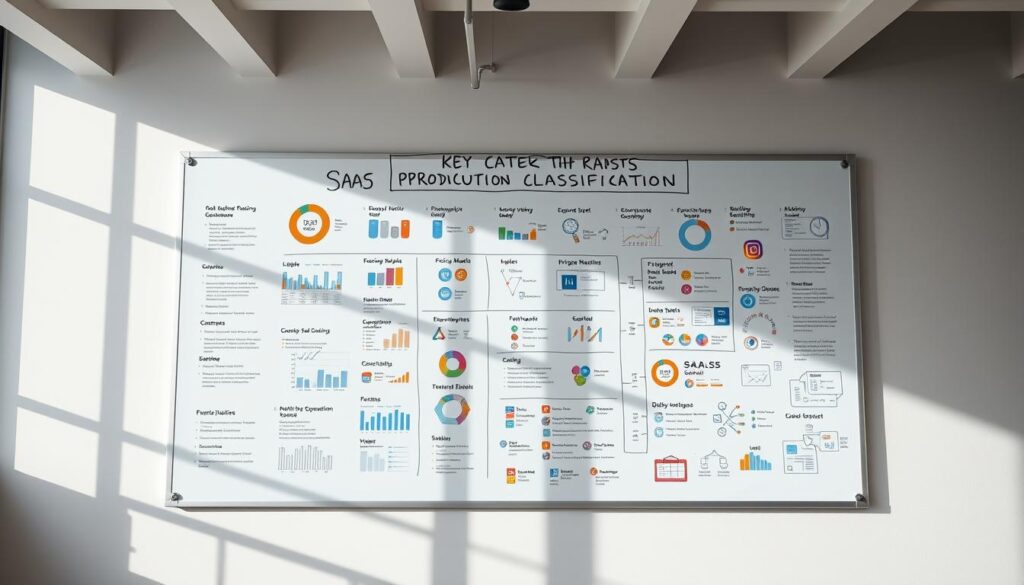7 Key Rules for Best AI SaaS Product Classification Criteria
15 min read
Table of Contents
The use of Artificial Intelligence in SaaS solutions is changing industries fast. As more businesses use AI tools, it’s important to have clear rules for classifying these products.

The AI market is expected to grow a lot. Knowing how to classify AI SaaS products is key for businesses to succeed in this fast-changing world.
This article will show you the 7 main rules for accurate classification. These rules help make better decisions and follow important rules.
The Evolving Landscape of AI SaaS Products
The AI SaaS market is changing fast, thanks to new tech and what users want. This makes it harder to sort out what AI SaaS products are.
Recent Market Developments
In recent years, more AI SaaS products have popped up. Companies are adding AI to their software. Now, we have a market full of different products, from simple tools to big enterprise solutions.
Key trends include:
- More AI in different industries
- New AI tech and methods coming out
- People want AI solutions that are big and safe
Why Classification Has Become Critical in 2023
In 2023, it’s key to sort out AI SaaS products well. This is because we need to follow rules and be clear about what we offer. As the market keeps changing, good sorting helps businesses make smart choices and meet industry standards.
Classification criteria will look at things like what the product does, its AI level, and what it needs for its industry.
AI SaaS Product Classification Criteria: The New Industry Standard
The world of AI SaaS products is getting more complex. This has led to a need for standardized ways to classify them. As the industry grows, having one unified system is more important than ever.
Evolution of Classification Approaches
Before, AI SaaS products were classified based on what they did or where they were used. But as technology improved, a more detailed method was needed.
Some important changes in how we classify AI SaaS products include:
- Adding machine learning features
- Looking at how data is handled and privacy
- Checking how easy the product is to use
These updates have helped create better ways to sort AI SaaS products. This makes it easier to understand and compare them.
Major Industry Players Adopting Standardized Criteria
Big names in the industry are starting to use the same classification rules. This move towards standardization will make it easier to compare and compete in the AI SaaS market.
Benefits of using standardized criteria include:
- It makes products easier to compare
- Customers will understand products better
- It makes the industry more open
By using these standardized rules, leaders in the industry are setting a new standard for how AI SaaS products are categorized.
Rule 1: Functionality-Based Classification
Functionality-based classification is key in AI SaaS product categorization. It looks at the main functions AI SaaS products offer. This helps businesses understand what they can do and how they can be used.
Primary vs. Secondary Functions
It’s important to tell apart primary and secondary functions when classifying AI SaaS products. Primary functions are the main abilities that show what the product is for. Secondary functions are extra features that make the product even better.
For example, a product might mainly offer data analytics. Additional tools may include visual reports and data charts.
Recent Case Studies of Function-Based Categorization
Recent studies show how well functionality-based classification works. A study on machine learning for product classification found that grouping products by main functions makes them easier to find and use.

Many companies have used this method for their AI SaaS products. One company used saas product segmentation criteria to sort its products. This resulted in more satisfied customers and a drop in support requests.
These stories show how vital functionality-based classification is in the AI SaaS world.
Rule 2: AI Capability Assessment
Evaluating AI capabilities is key for classifying AI SaaS products. It helps understand the AI SaaS product classification criteria and the right AI classification for SaaS products. The assessment looks at how advanced and integrated AI technologies are in the SaaS product.
It’s not just about if AI is there; it’s about how it’s used. This includes checking the types of AI, like machine learning or natural language processing. It also looks at how these technologies improve the product.
The New Machine Learning Integration Framework
The new machine learning integration framework is a big part of AI assessment. It offers a clear way to check how machine learning is used in SaaS products. It looks at the model’s complexity, the training data, and its effect on the product.
Industry-Adopted AI Maturity Scoring System
The industry-adopted AI maturity scoring system is also important. It rates the AI technology in a SaaS product. It considers the AI algorithm’s complexity, the data quality, and the product’s ability to learn and improve.
Using these tools helps businesses correctly classify their AI SaaS products. This way, they can make smart choices about their development and marketing plans.
Rule 3: Industry-Specific Categorization
AI SaaS products are changing fast. Now, it’s important to sort them by the industries they help. This way, each sector gets what it needs.
Vertical vs. Horizontal Solutions: Latest Approaches
It’s key to know the difference between vertical and horizontal solutions. Industry-specific solutions are tailored for fields such as healthcare or finance. Horizontal solutions work for many industries.
- Vertical solutions give deep insights and special features for an industry.
- General-purpose solutions are adaptable and serve a wide range of industries.
- Choosing depends on what a business needs.
Emerging Industry Adaptation Requirements
AI SaaS products must fit each industry’s needs. For example, healthcare needs follow strict data rules like HIPAA.
- Know the rules and standards for each industry.
- Make product features that fit industry needs.
- Follow the security rules for each industry.
By focusing on specific industries, businesses can find the right AI SaaS products. This helps them make choices that really work for them.
Rule 4: User Experience Classification
Understanding user experience is key for categorizing AI SaaS products. As AI tech grows, how users interact with these products matters a lot.
New Interface Complexity Metrics are now important for user experience. These metrics check how simple, easy to use, and intuitive AI SaaS product interfaces are. By looking at these, companies can sort their products better and make users happier.
New Interface Complexity Metrics
These new metrics look at things like how easy it is to navigate and how well the product handles information. For example, a product with a straightforward interface is different from one that’s hard to figure out.
Updated Accessibility Standards
Accessibility standards have been updated too. Now, AI SaaS products must be usable by everyone, including those with disabilities. The new rules are stricter on visual, auditory, motor, and cognitive accessibility.
User Feedback Integration in Classification
It’s important to use user feedback when classifying products. This lets companies know what users think and make changes. This feedback loop keeps the classification up to date and accurate.
By focusing on user experience, companies can create better saas product categorization guidelines. Also, using machine learning for product classification makes the process more accurate and efficient.
Rule 5: Data Handling and Privacy Considerations
Data handling and privacy are now key in classifying AI SaaS products, post-GDPR. How AI SaaS products manage data is critical. This change is due to more rules and the need to follow them.
Recent Changes in Data Processing Classifications have been big. Many AI SaaS products are being looked at again because of how they handle data. New tech and more use of machine learning have made data classification more detailed.
Recent Changes in Data Processing Classifications
The way we classify data has changed a lot in recent years. Laws like the GDPR have played a major role in shaping current practices. Now, AI SaaS products are judged on how they deal with sensitive data and protect it.
Compliance-Based Categorization Post-GDPR Updates
After GDPR updates, rules for compliance have gotten stricter. AI SaaS products are now judged on their data protection rules. This includes how they store data, move it across borders, and follow data protection by design.
Classifying AI SaaS products based on data handling and privacy is complex. It needs a good grasp of the tech and the rules. Following these criteria helps businesses make sure their AI SaaS products are safe and private.
Rule 6: Integration Capability Assessment
Checking how well AI SaaS products integrate is key. As these products grow more complex, how they work with other systems matters a lot. This affects how useful and easy to use they are.
Integration capability assessment looks at how well a product fits into different systems and data sources. It’s important to see how well it can help businesses work better and more efficiently.
New API and Ecosystem Compatibility Standards
New standards for APIs and ecosystems have changed how AI SaaS products integrate. These standards help products talk to other systems smoothly. This makes data sharing and automating workflows easier.
Some important features of these standards are:
- Stronger API security
- Better data formatting and standardization
- More compatibility with different ecosystems
Integration Complexity Levels: Current Benchmarks
Integration complexity levels show how hard it is to link a SaaS product with others. Today, we have benchmarks for this complexity:
- Low complexity: Easy integrations with little data sharing
- Medium complexity: Integrations needing some data exchange and processing
- High complexity: Complex integrations with many data sources and advanced processing
Knowing these levels helps businesses figure out what they need for integration. It also helps them pick the right AI SaaS products for their needs.
Rule 7: Scalability and Performance Metrics
AI SaaS products are growing fast, and scalability and performance are key. Knowing how well they can handle different situations is now vital. This helps in categorizing them effectively.
Updated Growth Accommodation Categories
When classifying AI SaaS products, we look at their growth capacity. Updated growth accommodation categories focus on elasticity, load balancing, and resource allocation. These help businesses see how scalable different AI SaaS products are.
- Elasticity: The ability of a product to scale up or down according to demand.
- Load Balancing: The distribution of workload across multiple resources to ensure efficient performance.
- Resource Allocation: The strategic assignment of resources to meet the product’s scalability needs.
Performance Benchmarking Standards for2023
To classify AI SaaS products right, we use performance benchmarking standards. These standards, updated for 2023, help evaluate AI SaaS products’ performance. Important metrics include response time, throughput, and reliability.
Real-World Scaling Challenges and Solutions
Scaling AI SaaS products comes with challenges, like keeping performance up during busy times. Real-world scaling challenges and their solutions include:
- Implementing auto-scaling features to dynamically adjust resources.
- Utilizing load balancing techniques to distribute traffic efficiently.
- Adopting robust data management practices to maintain data integrity during scaling.

By understanding and applying these metrics, businesses can make better choices. This improves their efficiency and competitiveness in the market.
Implementation Challenges and Industry Response
Starting the 7 key rules for AI SaaS product classification comes with its own set of problems. Many who tried it first have shared their struggles. The industry is now working on ways to tackle these issues.
Common Obstacles Reported by Early Adopters
Those who were among the first to use AI SaaS product classification faced several big challenges. These include:
- It’s hard to figure out how good AI is and how mature it is
- Sorting products by what they do and what industry they fit into is tough
- Keeping up with rules about handling data and privacy is a big task
These problems show why we need machine learning for product classification. It’s needed to make the process smoother and more accurate.
Strategic Approaches to Overcome Classification Hurdles
To get past these challenges, companies are taking certain steps. These include:
- Creating their own classification systems that fit their business
- Training employees to better understand AI SaaS product classification
- Working with industry experts to keep up with new standards and methods
By applying these strategies, businesses can overcome the challenges of categorizing software-as-a-service solutions. They can also make sure they follow the rules of the industry.
Conclusion
The AI SaaS world is changing fast. Good product classification is now key for businesses. This article shared 7 important rules for classifying SaaS products with AI.
Following these rules helps companies meet industry standards. It also makes it easier to use machine learning for better product sorting. This leads to more precise categorization of SaaS products.
As new trends and tech emerge, the need for smart AI SaaS product classification grows. By knowing and using these 7 rules, businesses can lead the way. They can succeed in a tough market.
FAQ
What are the key factors to consider when classifying AI SaaS products?
To classify AI SaaS products, consider their functionality, AI capabilities, and industry. Also, think about user experience, data privacy, integration, and scalability. These factors help in categorizing AI SaaS products effectively.
How do recent market trends impact the classification of AI SaaS products?
Market trends have made classifying AI SaaS products more important. This is due to their growing complexity, new regulations, and what the market expects.
What is the significance of functionality-based classification for AI SaaS products?
Functionality-based classification is key. It helps separate main and secondary functions. This makes it easier to compare and categorize AI SaaS products accurately.
How is AI capability assessment performed for SaaS products?
Assessing AI capabilities involves looking at the machine learning framework and AI scoring systems. This helps determine how advanced AI is in SaaS products.
What are the differences between vertical and horizontal solutions in industry-specific categorization?
Vertical solutions focus on specific industries, while horizontal solutions work across many. New methods help tell these apart.
How do updated accessibility standards impact user experience classification?
New accessibility standards make AI SaaS products more inclusive and user-friendly. Using user feedback improves the classification process and user experience.
What are the implications of GDPR updates on compliance-based categorization for AI SaaS products?
GDPR updates have changed how data is processed. Compliance-based categorization ensures AI SaaS products meet these new rules.
How do new API and ecosystem compatibility standards affect integration capability assessment?
New standards make integrating AI SaaS products with other systems easier. Current benchmarks help measure integration complexity.
What are the key considerations for scalability and performance metrics in AI SaaS products?
Scalability and performance metrics focus on growth, benchmarks, and real-world challenges. They help evaluate how well AI SaaS products scale.
What are the common obstacles reported by early adopters of the 7 key rules for AI SaaS product classification?
Early adopters face challenges like implementing the rules, lack of standardization, and limited resources. Strategic approaches can help overcome these issues.
How can businesses ensure effective classification and compliance with industry standards for AI SaaS products?
Businesses can follow the 7 key rules, stay updated with industry trends, and engage with other players. This ensures effective classification and compliance.
Reader Ratings & Reviews
There are no reviews yet. Be the first one to write one.
